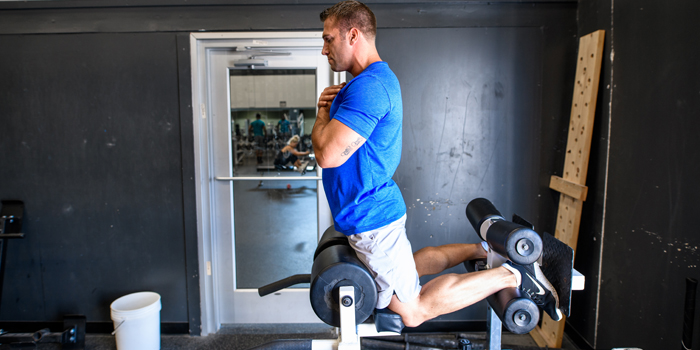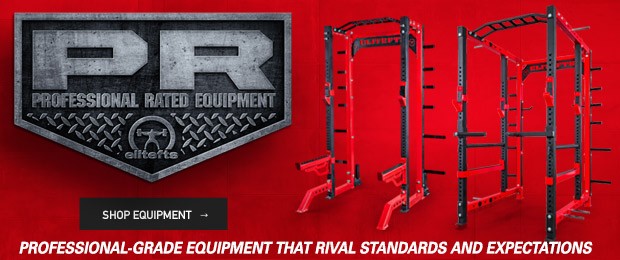
The rise of glute training has been made popular, for the most part, by women. If you follow the "glute guy," Bret Contreras, on IG you've likely seen scores of before and after photos with ladies going from zero glutes to competing on stage as figure athletes. In terms of aesthetics, glute development tends to be something that is more important to the ladies, but what about the dudes out there? We, too, can benefit from regular direct glute work.
RECENT: 10 Training Mistakes to Avoid
I'll admit I absolutely hated the glute bridge and glute hip thrust for a LONG time, mainly because it was a pain in the ass to set up and because I've never been one to actually "feel" like I was getting the intended benefits.
After nearly a year of being force-fed direct glute training while training with my wife, I've been able to notice a few things:
- My lower back feels better: I've had lower-back issues — mainly the left SI joint — for years and heavy conventional deadlifts irritate the F out of it.
- My lifts have gone up: My front and back squat, as well as my pulls, have increased.
- Gains in lean body mass: This past year I've put on five pounds. Now, is that mainly because of more direct glute work? Probably not solely, but my wife has noticed that my glutes are bigger, which is a win. I often refer back to something I heard Louie say at Westside a few years ago and it was "I've never seen a strong person with a small ass." That same day he told me I had a weak ass, which got my wheels turning.
Needless to say, glute training has become a cornerstone piece in my own programming, as well as the individual programming I write for my clients.
Glute Training Benefits
Most are probably aware of the role of the gluteals plate in hip-extension, but the gluteals are also responsible for hip-external rotation, hip-abduction, and posterior pelvic tilt. Some of the benefits include:
- Knee-health: Strong glutes help keep the knees in a stable position by preventing knee valgus (inward knee collapse).
- Lower-back health: If the glutes are weak, you'll rely more on your lower-back to perform hip-extension based movements. This adds stress on the spinal discs and ligaments, likely increasing the chance of injury.
- Increase your squat and deadlift: We know that the glute complex is the largest muscle in the human body and plays a key role in hip-extension, so it's not unlikely to think this will correlate to improving the squat and deadlift.
- Look better naked: If you don't care about aesthetics, great. But I'm fine with thousands of people reading this article knowing that I care what my ass looks like.
Furthermore, based on my own personal experience, as well as training clients over the last 15 years, I've yet to encounter someone that has a strong set of glutes naturally. Heck, my glutes were quite weak even though I've been "training" them for the last 20 years. This is certainly low-hanging fruit and something as coaches we’re always looking for.
The Movements and Programming
I'm going to keep this list relatively simple and short; it won't require any special equipment with the exception of the one "bonus exercise." These are movements that you can include in your programming right away to be used in a number of settings. I'll include information on this as well. One caveat though — just because you can pull and squat a metric fuckton doesn't mean you're going to be moving a ton of weight with these movements. At the moment, I'll admit I train with nearly the same loads my wife uses despite having a squat/deadlift three times hers.
Remove your ego and work on getting a full range of motion so you can actually feel the glutes working — the glute bridge and hip thrust work best when terminal end range of motion is achieved on each repetition. Additionally, for some, their hamstrings tend to predominate these movements. If that's the case, you'll need to adjust the load further (make sure your full foot is planted.)
Lastly, enclosed are two movements that are intended to be used in your warm-up NOT as main movements. For some, these are a great place to start to start to improve the mind-muscle connection with the gluteals.
Glute Warm-up
The banded glute bridge and X-band walk with good mornings are my go-to activation drills to be used in your warm-up. I prefer to use both variations each week — one on a ME lower day, the other on DE lower day, but I tend to include these on conditioning days as well regularly.
The goal with these drills is to stimulate, not annihilate so don't go crazy with these — a little bit goes a long way.
Banded glute bridge: 4 x 5 - 1 count squeeze at top. Rest 60 seconds between sets.
X-band walk with good mornings: 3 x 5 right + 5 left + 5 good mornings. Rest 60 seconds between sets.
1. The Glute Bridge
This variation probably doesn't come as a shock, but many typically opt for the glute hip thrust simply because the ROM is greater. I'd urge you to consider keeping its baby brother, the glute bridge, in your programming. Why? Put simply, it's a regression to the glute hip thrust and actually may suit many people much better than the glute hip thrust based on individual anthropometrics. This is a good example of bio-individuality and that opting for the "harder" variation isn't always the best option.
Programming
4-5 x 8-15
2. The Glute Hip Thrust
The glute hip thrust has made quite a name for itself thanks guys like Dr. Bret Contreras. The glute hip thrust utilizes all four actions of the glutes: Hip external rotation, hip abduction, hip extension, and posterior pelvic tilt. There are few caveats when using the variation, though, to really reap the benefits. The first is, your set-up can make or break the effectiveness and as you can see, we've elevated the plates in this video to keep constant tension through the entire ROM.
If you're lucky enough to have a glute thruster bench from Bret, then you won't have to worry about elevating the plates. The height of that bench is 12 inches versus a standard 16 inch bench. The second thing is, don't sacrifice load for ROM. I often see people missing 10 to15 percent of terminal end ROM just to use heavier loading.
Additionally, this variation could be programmed for heavier work — three to six RMs — but I've personally found this variation to be more effective in the 8 to 10 rep range. Although I have gone as high as 20 rep sets, so feel free to experiment.
Programming
4 x 8-10
3. Safety Bar Back Raises
For many, the 45 degree back raise is a common movement pattern and put simply, it works. This movement has been proven to have high EMG ratings for gluteal activity. For this reason, we’ve included it on our list, but we can change the demand of this movement a number of ways by using additional resistance with the safety squat bar.
This variation can also be accomplished on a GHD, but take note that the joint angle is different, so the level of gluteal activity certainly is not the same.
Programming
4-5 x 10-15 with safety squat bar
OR
4 x 25 with a light medicine ball against your chest
4. Cable Pull-Through
The cable pull-through is probably nothing new to most of you, but this variation works quite well in a metabolic-stress situation as a "finisher" for high-volume. Of course, if you don't have access to a cable machine, the same variation can be done with a band. Keep in mind the effect is different since when you're using a band tension increases/decreases through range of motion, whereas with a cable machine there is constant tension. Either way, the band is a great option, too, just make sure you're going with a heavier band. A light to average band works well.
Programming
Accumulate 100 reps at the end of your session, resting as little as possible
5. The Dimel Deadlift
The Dimel deadlift is a nice high-rep variation with a short, explosive range of motion that will make your glutes sing like a choir boy. Because the ROM is small the glutes and hamstrings are under constant tension. The one caveat is that these should be done explosively with aggressive hip extension (not hyperextension) at end range motion.
And because the volume is high per set (typically 30 reps per set), there is a high amount of metabolic stress. This variation was made popular by Matt Dimel to train the lockout of the deadlift.
Programming
3 x 30 @ 30 to 40 percent of 1RM deadlift
*Bonus Reverse Hypers™
Another specialty piece that you may not have access to, but if you do, consider it a huge win. I often get the question, “What can I place the Reverse Hyper™ with?” The honest answer is nothing. Of course, there are comparable movements in terms of training the same musculature, but the effect of this piece of equipment is unlike any other.
In this case, we are going to work on controlled repetitions where the pendulum does NOT swing out of control. At the top of each repetition, we are going to squeeze our glutes HARD.
RELATED: 6 Training Rules for the Washed-Up Meathead
For those that are accustomed to using the Reverse Hyper™, you can use 50 percent of your back squat 1RM for 100 total repetitions. If you’re new to using the Reverse Hyper™, start with half of that for both loading and volume.
Programming
Beginner: 3 x 15
Advanced: 4 x 25 @ 50 percent of back squat
Sample Training Sessions
Max Effort Lower #1
- SSB box squat: Build to a 1RM in 10 sets. Rest 2:00 minutes.
- Glute bridge: 5 x 8-10. Rest 90 seconds.
- DB reverse lunges: 3 x 8-10 each. Rest 60 seconds.
- Cable pull-throughs with a wide stance: Accumulate 100 Reps. Rest as needed.
Max Effort Lower #2
- Sumo rack pull with chains: Build to a 1RM in 10 sets. Rest 3:00 minutes.
- Front squat to pins: Build to a heavy 4 in 6 sets. Rest 2:00 minutes.
- Glute hip thrust: 4 x 8-10. Rest 90 seconds.
- SSB back raises: 4 x 10-15. Rest 60 seconds.
Dynamic Effort Lower #1
- SSB box squat: 6 x 4 @ 50 percent + 25 percent of band tension, every 60 seconds.
- Sumo rack speed pull: 6 x 2 @ 50 percent + 30 percent of band tension, every 60 seconds.
- Glute ham raises: 4 x 6-10. Rest 90 seconds.
- Dimel deadlift: 3 x 30 @ 30 percent of deadlift. Rest 90 seconds.
Dynamic Lower #2
- Speed front squats: 9 x 3 @ 50 percent + 25 percent chain, every 60 seconds.
- Conventional speed pull deadlift: 9 x 1 @ 50 percent + 30 percent of band tension, every 30 seconds.
- Glute bridge: Build to a heavy 6 in 5 sets. Rest 90 seconds.
- Reverse Hypers™: 4 x 25 @ 50 percent of back squat. Rest 90 seconds.
Glute training isn’t just for the ladies to gain followers on IG. Direct glute training may be the missing element in your training to catapult your lifts to the next level. And if you’re part of the staggering number of people that suffer from lower-back disorders, glute training will help remove stress from the lower-back when you’re pulling heavy.
Header image credit: RX Photography











2 Comments